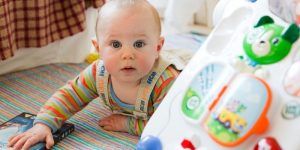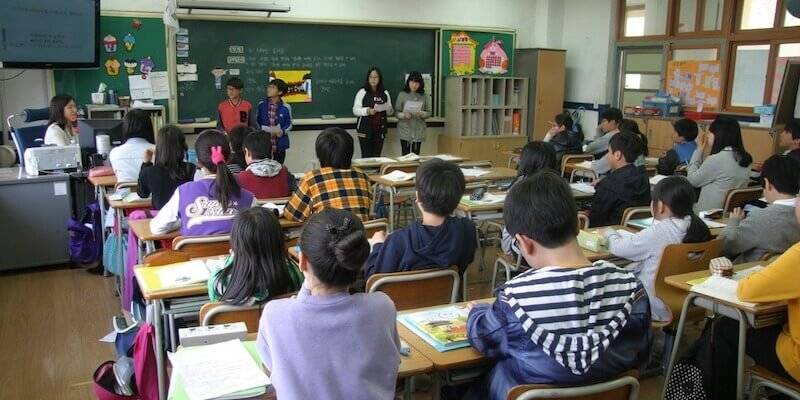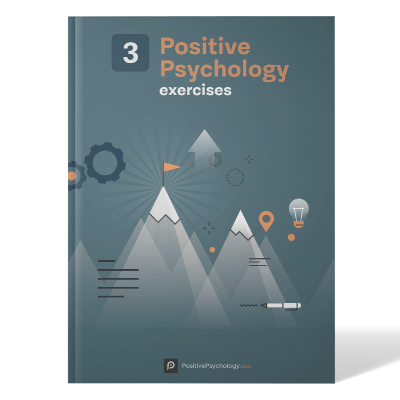What Is Cognitive Development? 3 Psychology Theories
 Cognitive development is certainly not an easy topic to grasp.
Cognitive development is certainly not an easy topic to grasp.
But don’t worry, we will try our best to help you with the essentials of this complex field of study.
We’ll start with some background, then show you how cognitive skills are used every day. In addition, we will explain a few theories and describe fascinating studies.
Since cognitive development goes beyond childhood and into adolescence, we are sure you will want to know all about this, too.
To end this article, we provide some helpful resources. You can use these to support the cognitive skills of your students or clients.
Before you continue, we thought you might like to download our three Positive Psychology Exercises for free. These science-based exercises explore fundamental aspects of positive psychology, including strengths, values, and self-compassion, and will give you the tools to enhance the wellbeing of your clients, students, or employees.
This Article Contains:
- What Is Cognitive Development in Psychology?
- Cognitive Development Skills & Important Milestones
- 5 Real-Life Examples of Cognitive Development
- 3 Ground-Breaking Cognitive Development Theories
- A Look at Cognitive Development in Adolescence
- 3 Fascinating Research Studies
- Helpful Resources From PositivePsychology.com
- A Take-Home Message
- References
What Is Cognitive Development in Psychology?
Cognitive development is how humans acquire, organize, and learn to use knowledge (Gauvain & Richert, 2016).
In psychology, the focus of cognitive development has often been only on childhood. However, cognitive development continues through adolescence and adulthood. It involves acquiring language and knowledge, thinking, memory, decision making, problem solving, and exploration (Von Eckardt, 1996).
Much of the research within cognitive development in children focuses on thinking, developing knowledge, exploring, and solving problems (Carpendale & Lewis, 2015).
Nature vs nurture debate
The nature versus nurture debate refers to how much an individual inherits compared to how much they are influenced by the environment. How do nature and nurture shape cognitive development?
American psychologist Arthur Jensen (1969, 1974) emphasized the role of genetics within intelligence, arguing for a genetic difference in the intelligence of white and Black people.
Jensen (1969) made some very bold assertions, stating that Black people have lower cognitive abilities. His research was heavily criticized for being discriminatory. He did not consider the inbuilt bias of psychometric testing (Ford, 1996). The lower test scores of Black individuals were more likely to be a result of a lack of resources and poor-quality life opportunities (Ford, 2004).
In an enormous cross-sample of 11,000 adolescent twins, Brant et al. (2013) found that those with a higher intelligence quotient (IQ) appeared to be more influenced by nurture and stimulation. The researchers suggested this may be because of their heightened attention and arousal system, absorbing more information from the environment, being more open to new experiences, and allowing brain plasticity and changes to occur.
They also found that adolescents with a lower IQ showed more genetic influence on their IQ from their parents. The researchers suggested that their lower levels of intelligence may result in lower motivation levels and an inability to seek out new experiences.
This study highlights the need for those with lower IQ levels to be supported with positive interventions to increase their cognitive abilities and capacity.
Cognitive Development Skills & Important Milestones

These milestones reflect skill achievement and take into account genetic makeup and environmental influence (Dosman, Andrews, & Goulden, 2012).
Here are a few of these important milestones, the associated skills, and the age at which they are typically achieved. The following table is modified from the Child Development Institute.
| Milestone | Description | Approximate age |
|---|---|---|
| Object permanence (early) | Follows an object until it is out of sight. Searches for a partially hidden object. |
4–8 months |
| Object permanence | Will search for a completely hidden object. | 9–12 months |
| Cause and effect | Begins to understand cause and effect in actions. Realizes how to get a response. | 9 months |
| Functional use of objects | Understands what objects are used for. | 12–15 months |
| Play (Representational) | Can use dolls in a functional manner. | 18 months |
| Play (Symbolic) | Can use an object symbolically to represent something else. | 2–3 years |
| Skills (Pre-academic) | Knows letters, numbers, shapes, and colors and can count. | 3–5 years |
| Thinking (Logical) | Understands conversation and multi-step problem solving. Understands others’ perspectives. | 6–12 years |
| Thinking (Abstract) | Abstract thinking, hypothesizing, and drawing conclusions. | >13 years |
Table 1. Children’s cognitive milestones and skill development
Language and other cognitive skills
Language skills are essential for a child’s ability to communicate and engage with others. These skills support other areas of a child’s development, such as cognitive, literacy, and social development (Roulstone, Loader, Northstone, & Beveridge, 2002).
The modified table below was sourced from the Australian parenting website raisingchildren.net.au and describes how language develops in children.
| Language activity | Approximate age |
|---|---|
| Singular word use. Often resembling exact words such as ‘dada’ meaning dad. Toward the end of 18 months, a child will be able to follow simple instructions such as ‘sit down’ and ‘get up.’ | 12–18 months |
| The use of two-word sentences. A child can understand what familiar people say and vice versa, and unfamiliar people understand about half of what they say. | 18 months–2 years |
| A child will make use of three to four words with more accuracy. Play is combined with talking. | 2–3 years |
| A child will illustrate abstract thought and show their thoughts and feelings through more complex conversations. The ability to discuss many topics is apparent at least by the end of 5 years old. There will be an understanding of basic grammar and stories. | 3–5 years |
| By now, children are becoming good at storytelling and putting together words and sentences creatively. Children can share opinions, and by the age of 8 years, they can have adult-style conversations. | 5–8 years |
Table 2. Language development from 0 to 8 years
Thinking skills
Thinking concerns manipulating information and is related to reasoning, decision making, and problem solving (Kashyap & Minda, 2016). It is required to develop language, because you need words to think.
Cognitive development activities helps thinking and reasoning to grow. Thinking is a skill that does not commence at birth. It develops gradually through childhood and advances more rapidly when children are around two years old. Reasoning develops around six. By the time they’re 11, children’s thinking becomes much more abstract and logical (Piaget, 1936).
Developing knowledge
Knowledge is essential for cognitive development and academic achievement. Increased knowledge equates to better speaking, reading, listening, and reasoning skills. Knowledge is not only related to language. It can also be gained by performing a task (Bhatt, 2000). It starts from birth as children begin to understand the world around them through their senses (Piaget, 1951).
Building knowledge is important for children to encode and retrieve new information. This makes them able to learn new material. Knowledge helps to facilitate critical thinking (Piaget, 1936). Clearly, the development of children’s knowledge base is a critical part of cognitive development.
Memory development
The development of memory is lifelong and related to personal experiences.
Explicit memory, which refers to remembering events and facts of everyday life, develops in the first two years (Stark, Yassa, & Stark, 2010). Explicit memory develops around 8 to 10 months.
Working memory and its increase in performance can be seen from three to four years through adolescence (Ward, Berry, & Shanks, 2013). This is demonstrated through increased attention, the acquisition of language, and increased knowledge.
Implicit memory, which is unconscious and unintentional, is an early developing memory system in infants and develops as the brain matures (Ward et al., 2013).
Perceptual skills
Perceptual skills develop from birth. They are an important aspect of cognitive development. Most children are born with senses of sight, hearing, touch, taste, and smell (Karasik, Tamis-LeMonda, & Adolph, 2014).
As children develop, they learn to communicate by interacting with their environment and using their sensory and motor skills (Karasik et al., 2014).
When visual, tactile, and auditory skills are combined, they emerge as perceptual skills. These perceptual skills are then used to gauge spatial relationships, discriminate between figure and ground, and develop hand–eye coordination (Libertus & Hauf, 2017).
Exploring and solving problems
Problem solving can be seen in very young children when they play with blocks, objects, and balls. It is entwined with perceptual skills and memory. Very young children playing with blocks, picking up a spoon, or even looking for objects demonstrate the development of problem solving skills (Goldschmied & Jackson, 1994). This is known as heuristic play (Auld, 2002).
As children develop cognitively and gain language, the problem solving then transfers to abstract thinking and solving logical problems (Needham, Barrett, & Peterman, 2002). Problem solving and exploring are interconnected. Science, engineering, and mathematics are all based around exploration and problem-solving skills.
5 Real-Life Examples of Cognitive Development
To understand how people think and process information, it is important to look at how cognitive skills are used in everyday life. Here are some real-life examples of cognitive development.
Decision making
To make a decision, a person needs to weigh up information and make the best choice. As an example, think about a restaurant menu. There is a lot of information on the menu about food options. Reading the menu requires you to analyze the data then reduce it to make a specific meal choice.
Recognition of faces
Have you ever wondered why it is possible to recognize a person even when they have grown a beard, wear makeup or glasses, or change their hair color?
Cognitive processing is used in facial recognition and explains why we still recognize people we meet after a long time, despite sometimes drastic changes in their physical appearance.
Cognitive-Behavioral Therapy (CBT)
This widely used therapeutic intervention is based on an understanding of cognition and how it changes behavior.
It is based on the premise that cognition and behavior are linked, and this theory is often used to help individuals overcome negative thinking patterns. CBT provides them with alternative positive thinking patterns to promote positive behavior.
Forgetting
The cognitive processes of short-term and long-term memory explain forgetting. An example of forgetting can be seen in students who do not study for exams. If they do not transfer the information from short-term to long-term memory, they forget the knowledge required for the examination and may fail.
Reasoning
Thinking and cognition are required for reasoning. Reasoning involves intellect and an attempt to search for the truth from new or existing information. An example of this activity can be seen in political debates on television.
3 Ground-Breaking Cognitive Development Theories

They all attempt to explain how cognitive development occurs.
Piaget’s cognitive development theory
Jean Piaget (1936) is famous for his theory of cognition that considers four specific stages of development.
The sensorimotor stage (0–2 years) is when infants build an understanding of the world through their senses and movement (touching, feeling, listening, and watching). This is when children develop object permanence.
The pre-operational stage (2–7 years) is when language and abstract thinking arise. This is the stage of symbolic play.
When a child is 7 years old, they enter Piaget’s concrete-operational stage, which goes up to 11 years. This is when logical and concrete thought come into action.
At the age of 11 onward, children learn logical and abstract rules and solve problems. Piaget described this as the formal operational stage.
Vygotsky’s theory
Lev Vygotsky described an alternative theory. He believed that children’s cognitive development arises through their physical interaction with the world (Vygotsky, 1932). Vygotsky’s theory is based on the premise that the support of adults and peers enables the development of higher psychological functions. His is known as the sociocultural theory (Yasnitsky, 2018).
Vygotsky believed that a child’s initial social interactions prompt development, and as the child internalizes learning, this shifts their cognition to an individual level.
Vygotsky (1932) considered children akin to apprentices, learning from the more experienced, who understand their needs.
There are two main themes of Vygotsky’s theory.
The zone of proximal development is described as the distance between the actual development level and the level of potential. This is determined by independent problem solving when children are collaborating with more able peers or under the guidance of an adult (Vygotsky, 1931).
This may explain why some children perform better in the presence of others who have more knowledge and skills but more poorly on their own. These skills, displayed in a social context but not in an isolated setting, are within the zone of proximal development. This highlights how a more knowledgeable person can provide support to a child’s cognitive development (Vygotsky, 1932).
Thinking and speech are considered essential. Vygotsky described a connected relationship between language development and the thinking process. His theory explains how younger children use speech to think out loud. Gradually, they evolve silent inner speech once mental concepts and cognitive awareness are developed (Vygotsky, 1931).
Ecological systems theory
Another more modern theory, similar in some sense to Vygotsky’s, is one by American psychologist Urie Bronfenbrenner (1974). He suggested that a child’s environment, within an arrangement of structures, has a differing impact on the child (Bronfenbrenner, 1974).
Bronfenbrenner’s five structures are the micro-system, mesosystem, ecosystem, macrosystem, and chronosystem. These concern the surrounding environment, family, school, values, customs, and cultures. They are interrelated, with each system influencing others to impact the child’s development (Bronfenbrenner, 1977).
Bronfenbrenner (1974) considered the micro-system as the most influential. This system contains the developing child, family, and educational environment, and impacts a child’s cognitive development the most.
A Look at Cognitive Development in Adolescence
Adolescence is a period of transition between late childhood and the beginning of adulthood.
Based on Inhelder and Piaget’s (1958) stage theory of cognitive growth, adolescence is when children become self-conscious and concerned with other people’s opinions as they go through puberty (Steinberg, 2005). The psychosocial context of adolescents is considerably different from that of children and adults.
The brain goes through a dramatic remodeling process in adolescence. Neural plasticity facilitates the development of social cognitive skills (Huttenlocher, 1979). Structural development of cortical regions of the brain may significantly influence cognitive functioning during adolescence (Huttenlocher, De Courten, Garey, & Van der Loos, 1983).
Recognition of facial expressions and emotion is one area of social cognition that has been investigated in adolescence (Herba & Phillips, 2004). The amygdala, a part of the brain associated with emotion processing, was found to be significantly activated in response to fearful facial expressions in a study of adolescents (Baird et al., 1999). This highlights that the development of emotional cognition is prominent in this age group.
3 Fascinating Research Studies

Here are three we find most interesting.
1. A cognitive habilitation program for children
Millians and Coles (2014) studied five children who had experienced learning and academic deficits because of prenatal alcohol exposure. Before and after an intervention, researchers gave standardized tests of nonverbal reasoning and academic achievement to the children.
Four of the five children showed increases to the average range of scores on measures of nonverbal, reasoning, reading, and mathematics. This study highlighted the benefit of interventions to address children’s cognitive difficulties and learning problems, even when the cognitive difficulties are apparent from birth.
2. Bilingual babies and enhanced learning
Introducing babies to two languages has been shown to improve cognitive abilities, especially problem solving (Ramírez-Esparza, García-Sierra, & Kuhl, 2017).
Spanish babies between 7 and 33.5 months were given one hour of English sessions for 18 weeks. By the end of the 18 weeks, the children produced an average of 74 English words and phrases. This study showed that the age between 0 and 3 years is the best time to learn a second language and gain excellent proficiency. However, languages can be learned at any time in life.
3. Unusual autobiographical memory
In an unusual case study, a woman described as ‘AJ’ was found to have highly superior autobiographical memory, a condition that dominated her life (Parker, Cahill, & McGaugh, 2006).
Her memory was described as ‘nonstop, uncontrollable and automatic.’ AJ did not use any mnemonic devices to recall. She could tell you what she was doing on any day of her life.
AJ could also recall her past with a high level of accuracy. This study provided some insightful details of the neurobiology of autobiographical memory and changes in the prefrontal cortex that cause these superior cognitive abilities.
Helpful Resources From PositivePsychology.com
If this article has piqued your interest and you wish to know more about improving cognitive function, take a look at these related posts.
How to Improve Cognitive Function: 6 Mental Fitness Exercises
This article describes ways to test your clients’ cognitive abilities. There are several exercises and games you may wish to use with your clients to help them improve their cognitive health and functioning, and help them maintain this throughout their lifespan.
10 Neurological Benefits of Exercise
Physical exercise is an excellent way to boost brain functioning. This fascinating article explains the benefits of exercise to buffer stress and aging, and maintain positive mental health and cognition.
Sleep Hygiene Tips
Alongside exercise, sleep is an essential component for the brain to function properly. This article has excellent sleep hygiene ideas, and you can use the checklists and worksheets to support your clients’ sleep, enabling them to boost their brain functioning.
17 Positive Psychology Exercises
If you’re looking for more science-based ways to help others enhance their wellbeing, this signature collection contains 17 validated positive psychology tools for practitioners. Use them to help others flourish and thrive.
A Take-Home Message
The first few years of a child’s life show rapid changes in brain development. This is part of the child’s cognitive development. There are a number of different theories of how and when this occurs. These are not set in stone, but are a guide to the cognitive development of children.
If children are not achieving their milestones at the approximate times they should, extra support can help make a difference. Even children with fetal alcohol syndrome can achieve considerably improved cognition with specialized support.
Remember, cognitive development does not end in childhood, as Piaget’s schema theory first suggested. It continues through adolescence and beyond. Cognitive development changes carry on through much of a teenager’s life as the brain is developing.
We hope you enjoyed reading this article. Don’t forget to download our three Positive Psychology Exercises for free.
- Auld, S. (2002). Five key principles of heuristic play. The First Years: Nga Tau Tuatahi. New Zealand Journal of Infant and Toddler Education, 4(2), 36–37.
- Baird, A. A., Gruber, S. A., Fein, D. A., Maas, L. C., Steingard, R. J., Renshaw, P. F., … Yurgelun-Todd, D. A. (1999). Functional magnetic resonance imaging of facial affect recognition in children and adolescents. Journal of the American Academy of Child & Adolescent Psychiatry, 38, 195–199.
- Bhatt, G.D. (2000). Organizing knowledge in the knowledge development cycle. Journal of Knowledge Management, 4(1), 15–26.
- Brant, A. M., Munakata, Y., Boomsma, D. I., DeFries, J. C., Haworth, C. M. A., Keller, M. C., … Hewitt, J. K. (2013). The nature and nurture of high IQ: An extended sensitive period for intellectual development. Psychological Science, 28(8), 1487–1495.
- Bronfenbrenner, U. (1974). Developmental research, public policy, and the ecology of childhood. Child Development, 45(1), 1–5.
- Bronfenbrenner, U. (1977). Toward an experimental ecology of human development. American Psychologist, 32(7), 513–531.
- Carpendale, J. I. M., & Lewis, C. (2015). The development of social understanding. In L. S. Liben, U. Müller, & R. M. Lerner (Eds.). Handbook of child psychology and developmental science: Cognitive Processes (7th ed.) (pp. 381–424). John Wiley & Sons.
- Dosman, C. F., Andrews, D., & Goulden, K. J. (2012). Evidence-based milestone ages as a framework for developmental surveillance. Paediatrics & Child Health, 17(10), 561–568.
- Ford, D. Y. (1996). Reversing underachievement among gifted Black students: Promising practices and programs. Teachers College Press.
- Ford, D. Y. (2004). Intelligence testing and cultural diversity: Concerns, cautions and considerations (RM04204). The National Research Center on the Gifted and Talented.
- Gauvain, M., & Richert, R. (2016). Cognitive development. In H.S. Friedman (Ed.) Encyclopedia of mental health (2nd ed.) (pp. 317–323). Academic Press.
- Goldschmied, E., & Jackson, S. (1994). People under three. Young children in daycare. Routledge.
- Herba, C., & Phillips, M. (2004). Annotation: Development of facial expression recognition from childhood to adolescence: Behavioural and neurological perspectives. Journal of Child Psychology and Psychiatry, 45(7), 1185–1198.
- Huttenlocher, P. R. (1979). Synaptic density in human frontal cortex – developmental changes and effects of aging. Brain Research, 163, 195–205.
- Huttenlocher, P. R., De Courten, C., Garey, L. J., & Van der Loos, H. (1983). Synaptic development in human cerebral cortex. International Journal of Neurology, 16–17, 144–54.
- Inhelder, B., & Piaget, J. (1958). The growth of logical thinking from childhood to adolescence. Basic Books.
- Jensen, A. R. (1969). Intelligence, learning ability and socioeconomic status. The Journal of Special Education, 3(1), 23–35.
- Jensen, A. R. (1974). Ethnicity and scholastic achievement. Psychological Reports, 34(2), 659–668.
- Karasik, L. B., Tamis-LeMonda, C. S., & Adolph, K. E. (2014). Crawling and walking infants elicit different verbal responses from mothers. Developmental Science, 17, 388–395.
- Kashyap, N., & Minda, J. P. (2016). The psychology of thinking: Reasoning, decision-making, and problem-solving. Psychology Learning & Teaching, 15(3), 384–385.
- Libertus, K., & Hauf, P. (2017). Editorial: Motor skills and their foundational role for perceptual, social, and cognitive development. Frontiers in Psychology, 8.
- Millians, M. N., & Coles, C. D. (2014). Case study: Saturday cognitive habilitation program children with prenatal alcohol exposure. Psychological Neuroscience, 7, 163–173.
- Needham, A., Barrett, T., & Peterman, K. (2002). A pick-me-up for infants’ exploratory skills: Early simulated experiences reaching for objects using ‘sticky mittens’ enhances young infants’ object exploration skills. Infant Behavior and Development, 25, 279–295.
- Parker, E. S., Cahill, L., & McGaugh, J. L. (2006). A case of unusual autobiographical remembering. Neurocase, 12(1), 35–49.
- Piaget, J. (1936). Origins of intelligence in the child. Routledge & Kegan Paul.
- Piaget, J. (1951). Play, dreams and imitation in childhood (vol. 25). Routledge.
- Ramírez-Esparza, N., García-Sierra, A., & Kuhl, K. P. (2017). The impact of early social interaction on later language development in Spanish–English bilingual infants. Child Development, 88(4), 1216–1234.
- Roulstone, S., Loader, S., Northstone, K., & Beveridge, M. (2002). The speech and language of children aged 25 months: Descriptive date from the Avon Longitudinal Study of Parents and Children. Early Child Development and Care, 172, 259–268.
- Stark, S. M., Yassa, M. A., & Stark, C. E. L. (2010). Individual differences in spatial pattern separation performance associated with healthy aging in humans. Learning and Memory, 17(6), 284–288.
- Steinberg, L. (2005). Cognitive and affective development in adolescence. Trends in Cognitive Sciences, 9, 69–74.
- Von Eckardt, B. (1996). What is cognitive science? MIT Press.
- Vygotsky, L. S. (1931). Adolescent pedagogy: The development of thinking and concept formation in adolescence. Marxists.org.
- Vygotsky, L. S. (1932). Thought and language. Chapter 6: The development of scientific concepts in childhood. Marxists.org.
- Yasnitsky, A. (2018). Vygotsky’s science of superman: from utopia to concrete psychology. In A. Yasnitsky (Ed.). Questioning Vygotsky’s legacy: Scientific psychology or heroic cult. Routledge.
- Ward, E. V., Berry, C. J., & Shanks, D. R. (2013). An effect of age on implicit memory that is not due to explicit contamination: Implications for single and multiple-systems theories. Psychology and Aging, 28(2), 429–442.
Let us know your thoughts
Read other articles by their category
- Body & Brain (41)
- Coaching & Application (49)
- Compassion (27)
- Counseling (46)
- Emotional Intelligence (23)
- Gratitude (16)
- Grief & Bereavement (19)
- Happiness & SWB (35)
- Meaning & Values (26)
- Meditation (21)
- Mindfulness (42)
- Motivation & Goals (42)
- Optimism & Mindset (33)
- Positive CBT (24)
- Positive Communication (21)
- Positive Education (41)
- Positive Emotions (28)
- Positive Psychology (33)
- Positive Workplace (38)
- Relationships (31)
- Resilience & Coping (33)
- Self Awareness (21)
- Self Esteem (38)
- Software & Apps (23)
- Strengths & Virtues (28)
- Stress & Burnout Prevention (27)
- Theory & Books (42)
- Therapy Exercises (30)
- Types of Therapy (53)




What our readers think
The article was excellent. I am a student doing research. This article went into key details, which is what I was looking for.
This article has tremendously helped me to come up with precise teaching notes for my educational psychology class. It is mu fervent hope that I will get more useful notes on social development.
Where did she learn her hypnotherapy? I am interested in learning as part of my holistic therapy.
Hi Ricardo,
Thank you for asking. I undertook my hypnotherapy training with The London College of Clinical Hypnosis (LCCH) in the UK. It is defined as ‘Clinical Hypnosis’ given that the course very much focused on medical conditions and treatment, but not entirely. They have been up and running since 1984 and are still course providers and a well recognised school globally. I am not sure where you are based in the world. Looking at their present website, I have noticed they also now provide online courses. Nevertheless there are many more organisations who provide Clinical Hypnosis training than when I undertook my course. I hope that helps you.